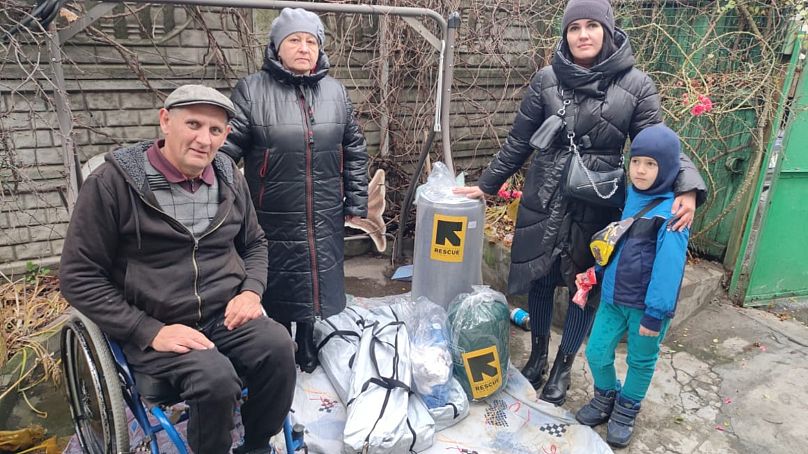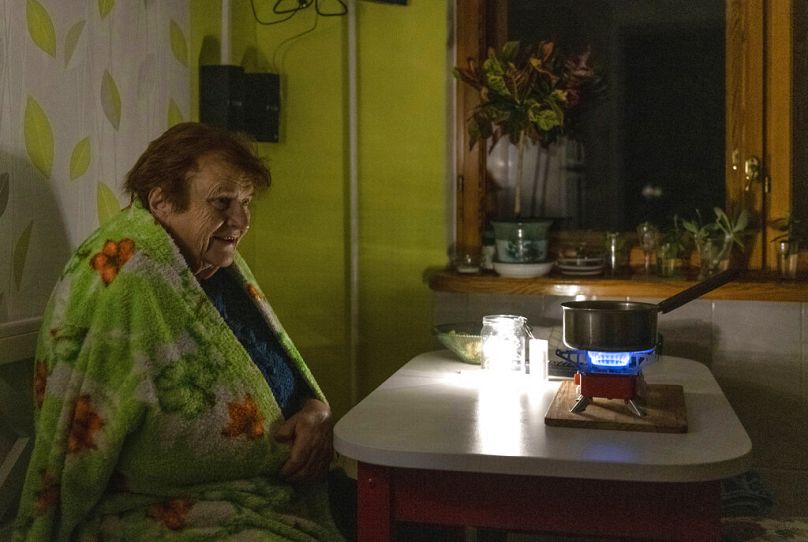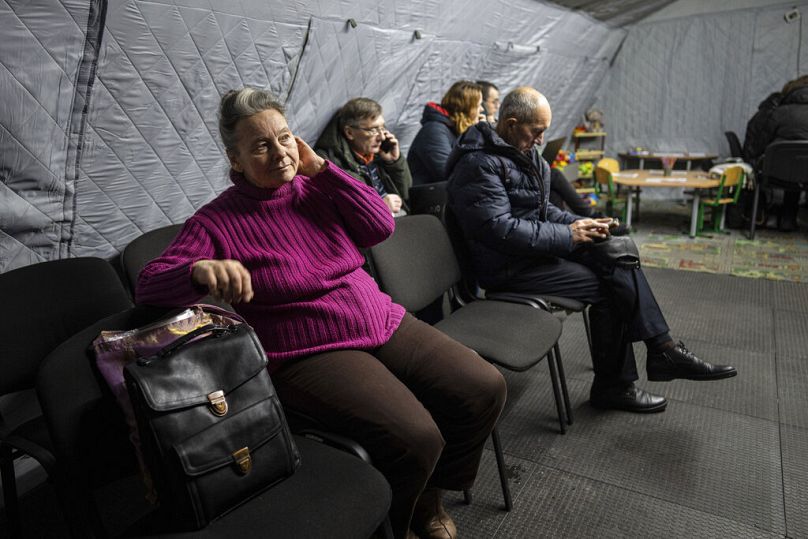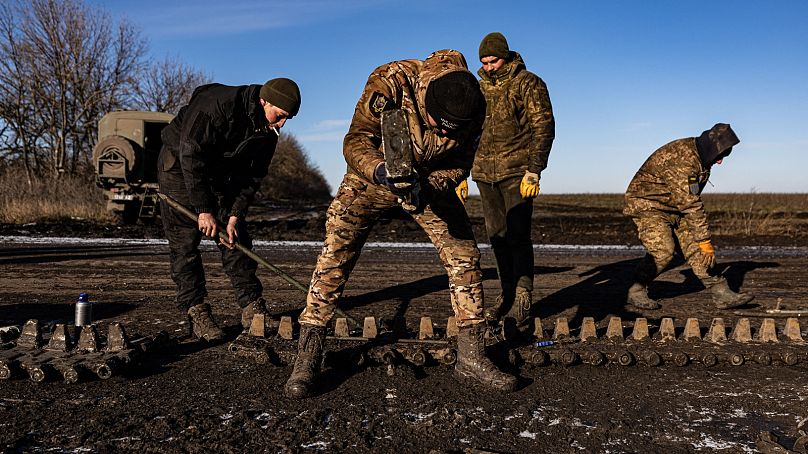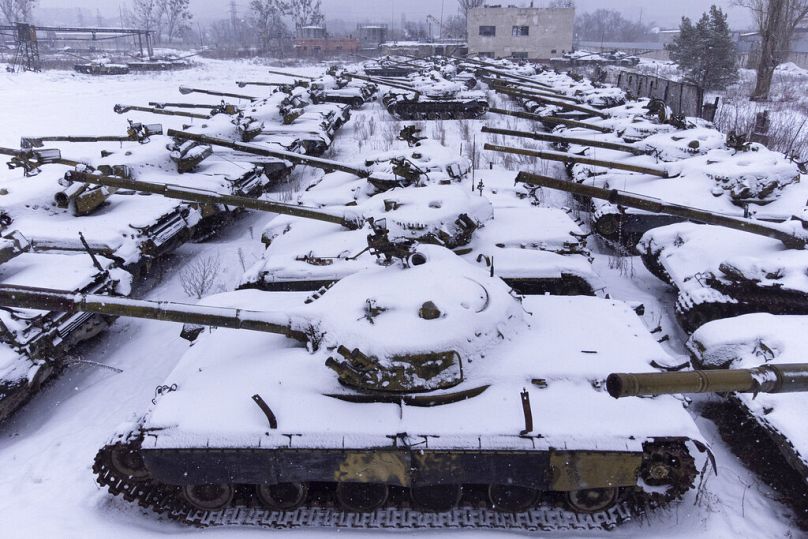Experts explain how the winter can impact the lives of civilians and military personnel.
Although many parts of Ukraine have been in the grip of wintry conditions for weeks already, the official meteorological start of winter happens on 21 December, the Winter Solstice, and the shortest day of the year.
Temperatures in Kyiv this week are hovering a few degrees above freezing, but extreme cold is not unusual and in the eastern Donbas region, where much of the fighting is taking place, winter temperatures have dropped below -30°C within recent memory.
As Russian forces repeatedly target Ukrainian infrastructure in the last few months, electricity supplies have become erratic, blackouts more frequent, and while repair crews have seemingly worked miracles to restore heat and power in the capital and other cities on a weekly basis, there is a recognition of how vulnerable those services can be.
So how might winter impact every aspect of life, and war, in Ukraine?
More people could flee their homes
The sustained Russian barrages on infrastructure sites -- and the impact that has on services like heating and electricity -- could mean another surge of Ukrainians who want to move to safer parts of the country or to a neighbouring country.
According to the International Rescue Committee, approximately 6.5 million people in Ukraine have been displaced and are facing freezing winter conditions after being forced to flee their homes.
"Many are taking shelter in damaged buildings and have limited access to food, electricity and heat," the IRC said.
An estimated 17.7 million people across Ukraine are in need of humanitarian assistance, and the IRC and other international agencies are scaling up their response as the weather gets colder -- distributing essential winter items, including blankets and heaters.
As temperatures plunge well below freezing, the lack of power and heat become life-threatening.
"With no power source, and with damage to their shelter, surviving the winter will be incredibly difficult for a large number of people,” said Marysia Zapasnik, the IRC's country director for Ukraine.
“It could also result in a dramatic increase in the number of people displaced, as they move to other parts of the country in search of warmth.”
The World Health Organization has also warned that conditions in Ukraine will increase rates of frostbite, hypothermia, pneumonia, stroke and heart attack -- and anyone who falls ill might not be able to access medical services which have been repeatedly targeted by Russia.
The head of the Norwegian Refugee Council told Euronews recently that "it is really a choice between freeze or fleeing".
"Europe has to prepare for hundreds of thousands of new refugees this winter from Norway in the north to the southern European countries," said Jan Egeland.
"We're in a race against the clock," he said. "Very many of these frontline communities have received little or no assistance in recent months.
How can Ukrainians cope with the cold?
For Ukraine's civilian population who stay in their homes, cold winter temperatures combined with possible electricity shortages will undoubtedly make life even more difficult.
Captain Mikael Aikio from the Finnish Army's Jaeger Brigade, which runs a centre of excellence for Arctic training in Lapland, says it's important for people to have even one hot meal per day.
"It has a lot to do with mental state if you get one warm meal a day, it helps psychologically, and gives you more energy. You have to think the food is good enough as well, and warm meals seem tastier to eat than a cold one, in cold weather," said Aikio.
Aikio, who is from Lapland himself, says that keeping warm is not necessarily about having some fancy, expensive clothing system, but about using the clothes you have most effectively.
"The idea is to have the basic layered principal, with several different layers and not just one big thick layer," he told Euronews from his base in Sodankylä, 130km north of the Arctic Circle.
"You trap air between the layers and you need to think about wearing the correct size: not too tight and a little bit loose to trap the air in between layers. Obviously, you need a base layer of underwear, then a middle layer for the insulation, and an outer layer which keeps the moisture out and gives protection from the wind," he explained.
Another piece of practical advice that Aikio passed along is to adjust the clothing depending on the activity. If people are doing something strenuous outside they should wear less clothing -- fewer layers -- than if they're inside their homes but without heating.
Kyiv authorities establish warm areas in the capital
A sharp cold snap in November and the first snow prompted authorities in the Ukrainian capital to come up with a new strategy.
Cold temperatures force Kyiv residents to turn on their heaters, which drastically increases the load on the electricity grid and makes power outages longer.
So Kyiv officials came up with the idea to establish a new network of communal heating points as their solution to the problem.
In the city of 3 million people, 528 emergency points have been identified. Here, residents are able to keep warm, drink tea, recharge their phones and get any necessary help.
The heating points are equipped with autonomous power sources, as well as special boiler rooms.
Military tactics change
The changing seasons will have a big effect on battlefield conditions and operations, not just for kinetic warfare but also for logistics and transport in areas where fighting is taking place.
During the muddy autumn in Ukraine, military vehicles were forced to use roads more, and not go off-road so much in case they got bogged down in the mud. But being forced to stick to roads made them more of a target, explained former military officer and author Frank Ledwidge.
"We will start to see activities pick up over the next couple of months. I'm sure of that. winter will slow things down but it will not stop them," he told Euronews.
"The cold itself has an effect on vehicle mechanics. I spent several winters in the Balkans as a military person, and in the winter every morning you have to put snow chains on your vehicle," Ledwidge explained.
"I also saw the kind of army that the Russians have, which was in most cases like the Serbian army trying to operate in the winter. The cold weather is unpleasant to work in. It is difficult to dig trenches because the ground is very hard. And that also applies to other fortifications."
Ledwidge said that vehicles might break down more easily, or not start at all, and that trucks could slide off icy roads, but generally the ground is hard so track vehicles and wheeled vehicles will still be able to move too.
"What we're not likely to see is a ground attack like this one we had in the Kharkiv area, where the Ukrainians broke through some very lightly-defended Russian lines by moving their forces very quickly."
Other considerations for Ukrainian -- and Russian -- forces during winter is less coverage in wooded areas where trees lost their leaves. Camouflage nets become easier to spot without the aid of foliage.
Soldiers adapt to cold weather conditions
Ukraine's military forces have been receiving winter gear from allies, but the same principles that apply to civilians for keeping warm also apply to military personnel: like wearing layers of clothing, and trying to eat one hot meal per day to keep up morale.
"There have been studies that show most cold weather-related injures happen more than six hours after the last warm meal, it has to do with energy levels dropping and then it's easier to get cold weather injuries like frostbite," explained Captain Mikael Aiko from the Finnish Army.
"We also train soldiers to work wet, and sleep dry, meaning they should always have a dry pair of socks and gloves or mittens to use, so they are not sleeping in wet gear," he said.
Of course, having a heated tent provides a longer-term solution for soldiers to warm up, or dry their kit overnight -- but because of the prevalence of thermal cameras that might not always be practical on the front lines.
Another option to stay warm is in the snow.
"It depends on how much snow you have, if you're in the mountains you might have a lot of snow so it's easier to dig a snow cave. It's warmer than being outside, usually just a couple of degrees below zero even if it's -20°C or -30°C outside," said Captain Aikio.
"But it's going to be moister, so again you need to work on the correct procedures so you can sleep well, but with a sleeping pad and a sleeping bag it is good to sleep in a snow cave," he said.
Another option with less snow is to dig a snow fox hole, "basically you dig yourself inside the snow and build a roof from something like branches, whatever you can use".












